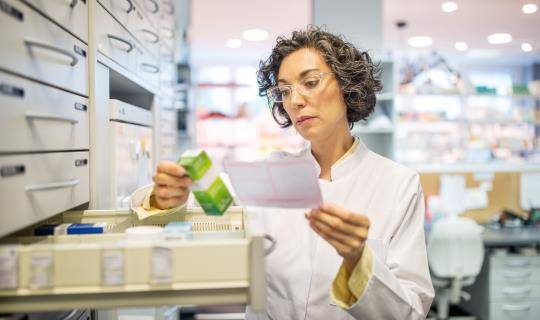Turning Your Pharmacy’s POS Data into Real-World Improvements
By Phyllis Houston, MSOL

Point-of-sale (POS) data encapsulates what’s happening during the final step for any customer who buys something at your pharmacy. As your associate scans an item at the checkout counter, the product barcode communicates with the POS system’s database, retrieving everything known about the item.
A lot happens during that transaction moment: The POS records not only what is being sold, but also the quantity, the price charged to the consumer, companion items purchased, method of payment, purchase date and time, and associate ID.
The POS pulls together all those key data points, forming a data core from which you can gain insight into uncovering patient trends, increasing pharmacy sales and improving store operations. Let’s look at some specifics on how to use POS data.
Stocking your front end
Disease state prevalence in your community and the buying patterns of your customer base will be reflected in POS data. So, as a starting point, the data reveals sales by product category—your bestsellers and laggards—giving you good guidance on what to stock and, conversely, what to carry less of or discontinue. This is especially important as buying habits continue to shift in the wake of the COVID-19 pandemic.
Use your POS data to identify what your most popular products are at the moment, determine what opportunities exist to sell complementary items together and take steps to increase sales in those areas. For example, many pharmacies set up a small display near checkout featuring in-demand products and cycle things in and out based on what their POS data is telling them. Also consider placing shelf talkers below key items to remind customers about complementary products. Further, top sellers and their companions are prime candidates for placement on an end cap or other high-traffic area (e.g., near the prescription counter).
Leveraging price reductions
Your pharmacy POS system automatically generates the proper sale price for any item on a temporary price reduction (TPR). That inherently streamlines the checkout process, but there’s a merchandising aspect to TPRs, too.
Items on TPR can be grouped with non-discounted products to help maximize sales (e.g., cough and cold medicine on TPR positioned next to regularly priced tissues). In the consumer’s eyes, it likely makes sense to buy both items. And you’re actually making your customers’ lives easier by saving them trips to different aisles (or even multiple stores) and offering everything they need in one convenient location.
Place TPR products in areas of the pharmacy where customers are most likely to see them. You don’t necessarily have to group promotional items together; alternatively, you could integrate appropriate items into a thematic display or end cap that gets changed out on a monthly basis.
Understanding the timing of transactions
The POS system captures the time of day and the day of week for every transaction. That information is valuable on two levels:
- When you identify periods of peak sales, you can adjust staffing models to coincide with actual in-store foot traffic. You may discover spikes, such as right after 5:00 p.m. when many people leave work, which might justify the addition of a part-time staffer for that shift.
- You don’t want to run out of a popular item before its replenishment order arrives. Use POS data to plot sales against time to ensure you have enough supply to last through periods of greatest demand.
POS data can also reveal whether a particular product sells well during certain times of the year (e.g., sunblock during warm-weather months). If a seasonal product is underperforming, chances are customers are having a hard time finding it.
Tracking results
Let’s say you recently did a reset in your vitamin section. You carefully selected the right mix of products and overall appearance within that area of the store. Now that it’s up and running, you don’t have to rely on intuitive feel or general impressions to gauge whether the transformation will be successful. Tap into your pharmacy POS system data to track product sales over time to determine the financial impact of the merchandising change.
Engaging customers
POS data can tell you how much a particular customer typically spends per basket and how many items are included. Drilling down, you can determine whether a customer only purchases prescription medication without buying front-end items, thereby creating an opportunity for you to offer ancillary products or services the next time they order a refill. On the flip side, you could identify and market prescription services to those who just shop the front end.
Other tactics include creating a color-coded list of complementary products for staff reference at the POS terminal (e.g., if the pharmacist puts a red sticker on a prescription, the checkout staffer knows to ask the patient if they would like to talk to the pharmacist about a vitamin supplement). A more general approach to boosting pharmacy companion sales would be to ask customers an open-ended question such as, “Did you find everything you were looking for?” or “Is there anything else you need today?” In any event, it’s good practice to interact with customers in the final transaction moment to find out if their needs have been fulfilled before they walk out the door or pull away from your drive-thru window. Feedback from those engagements can be matched up with hard POS data to help guide restocking of inventory.
In the final analysis, POS data puts hard numbers behind appropriate stocking, merchandising and replenishment of inventory, guiding your store toward more profitable operations.
Need more guidance on how to use POS data?







